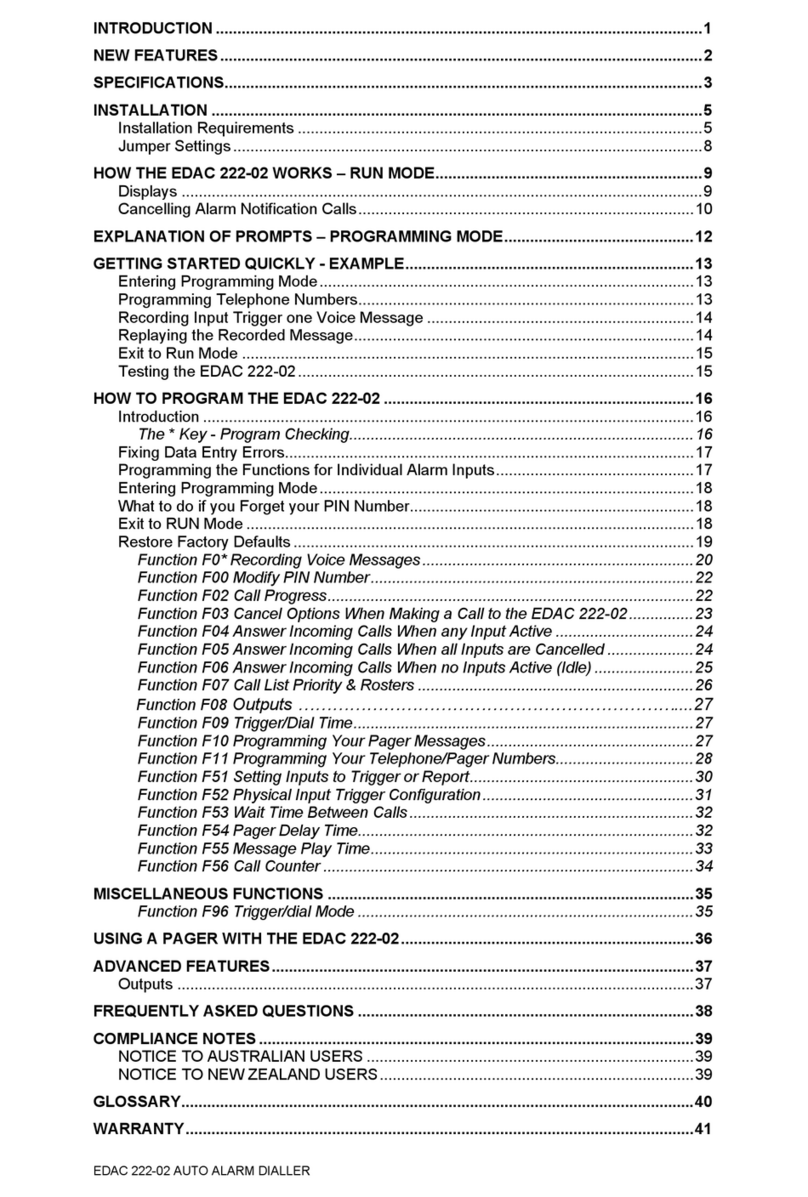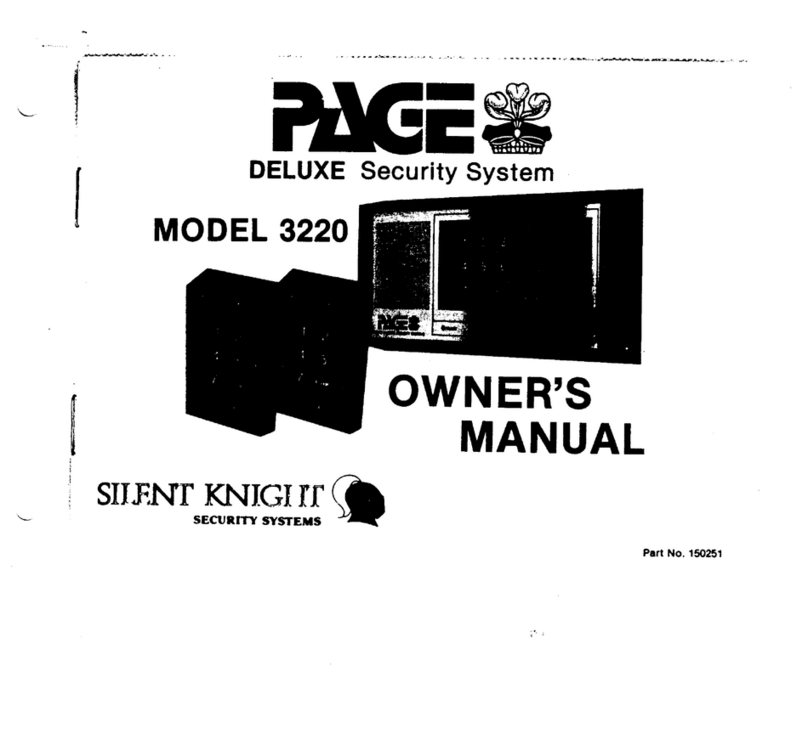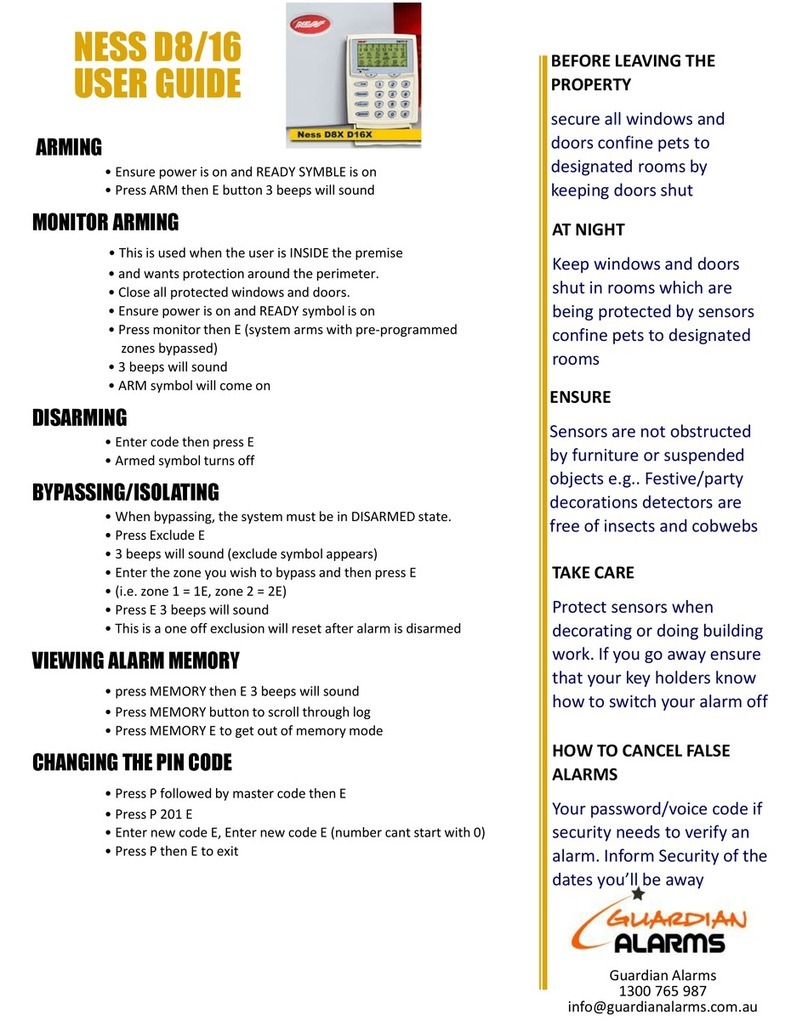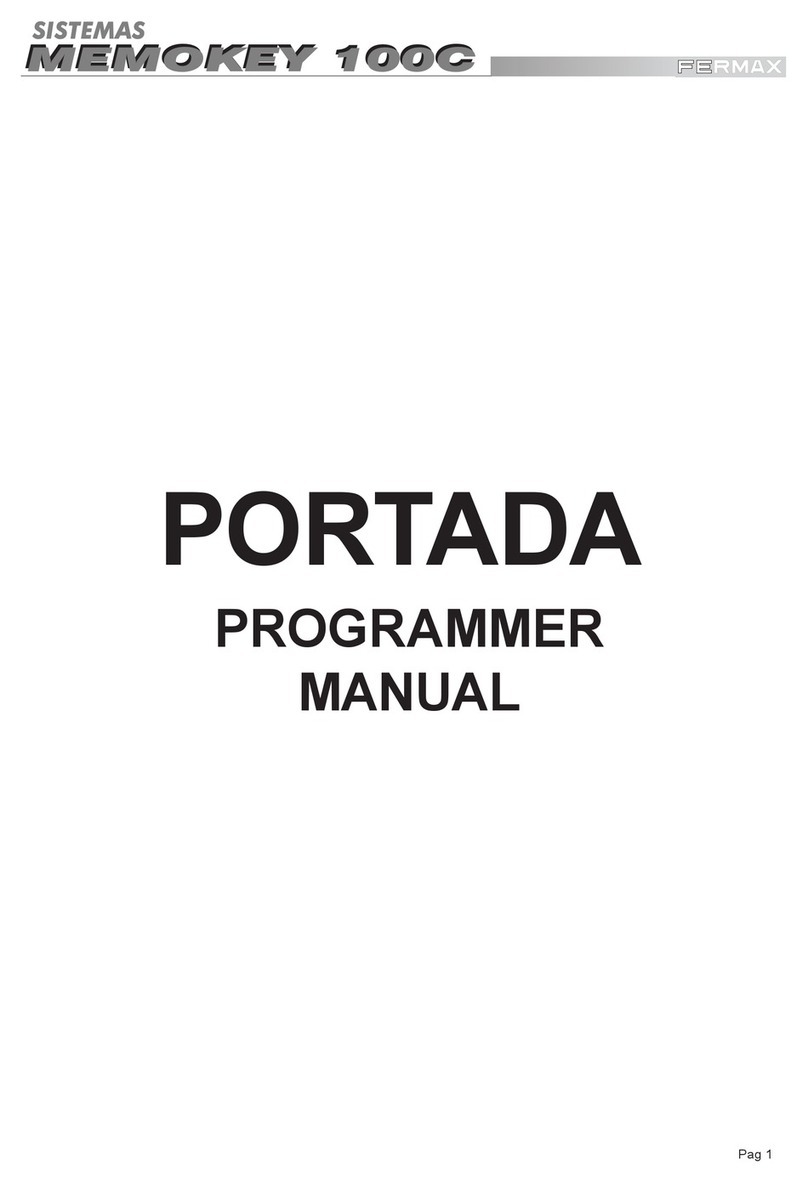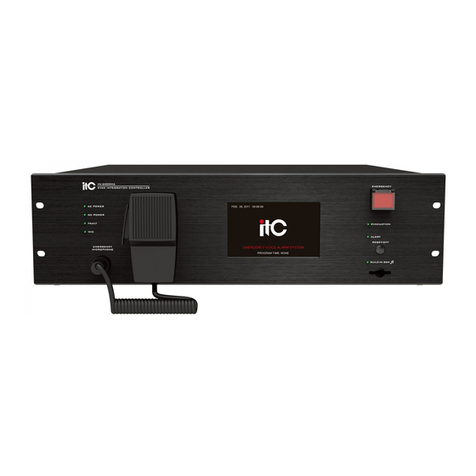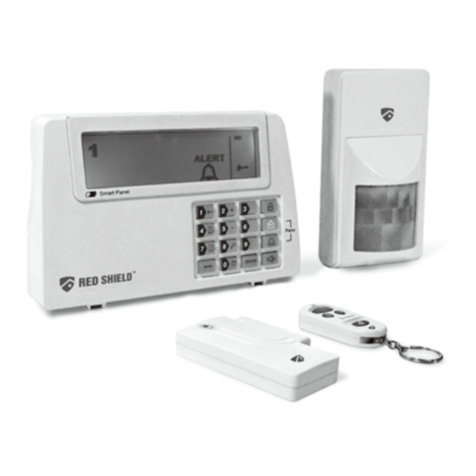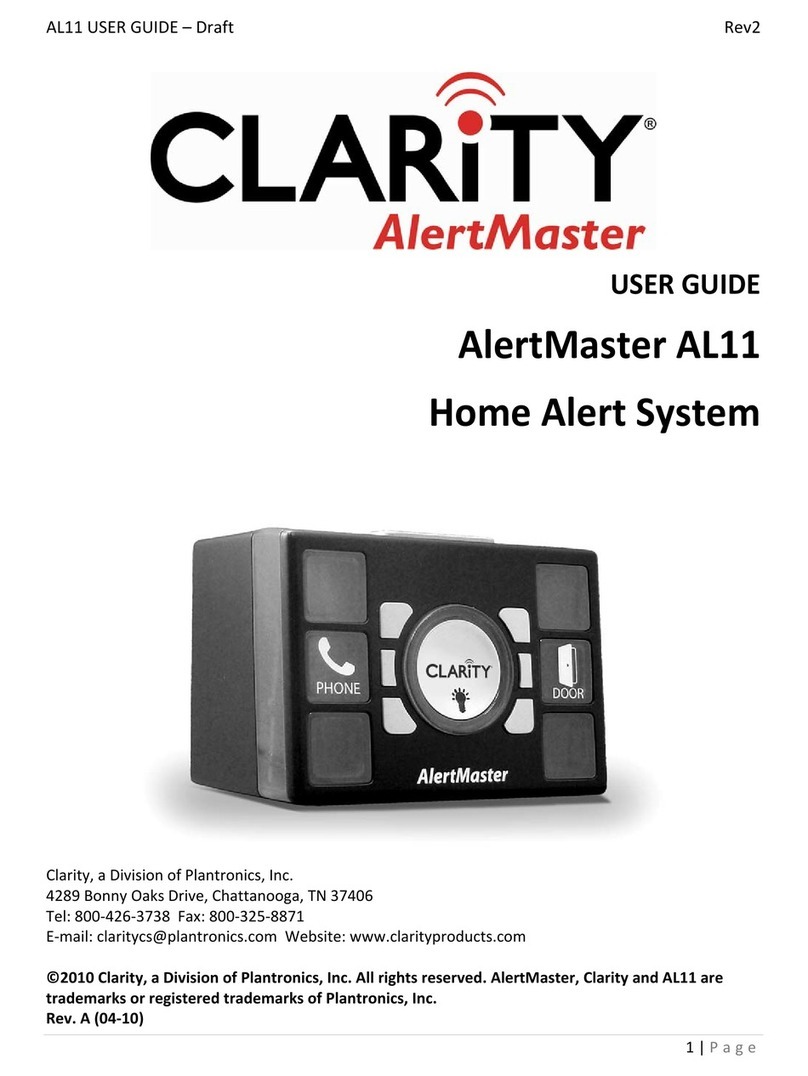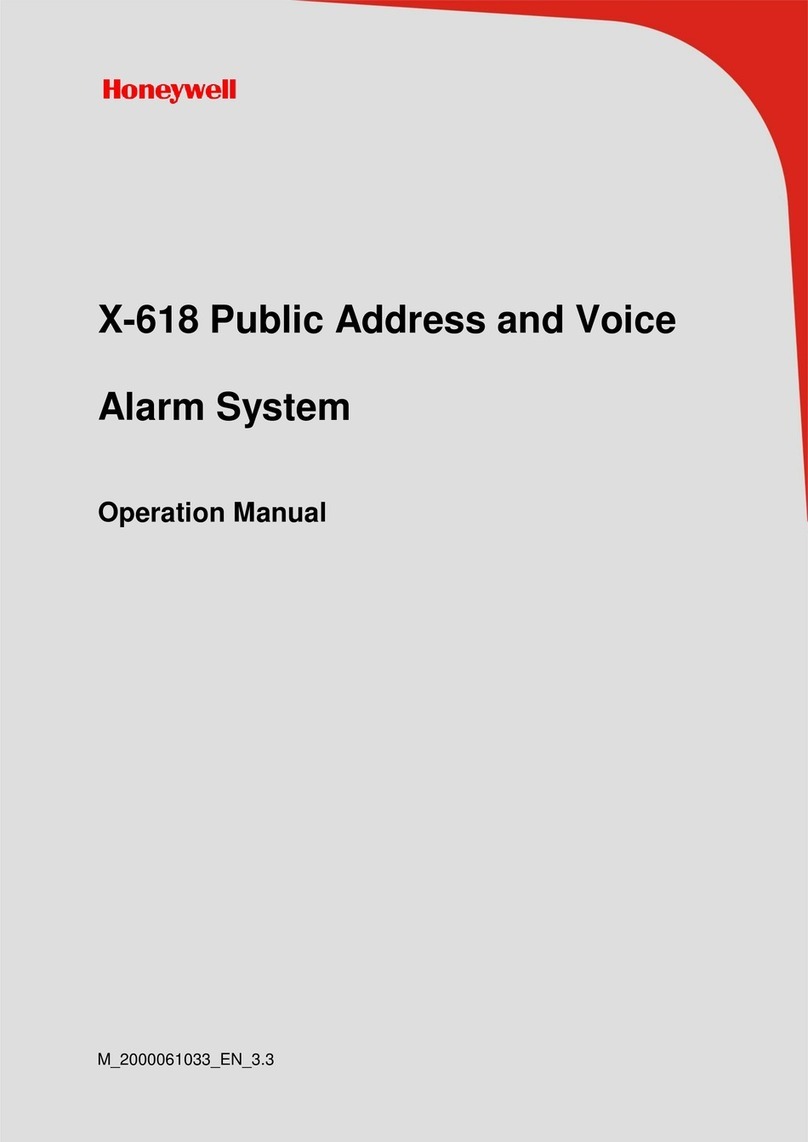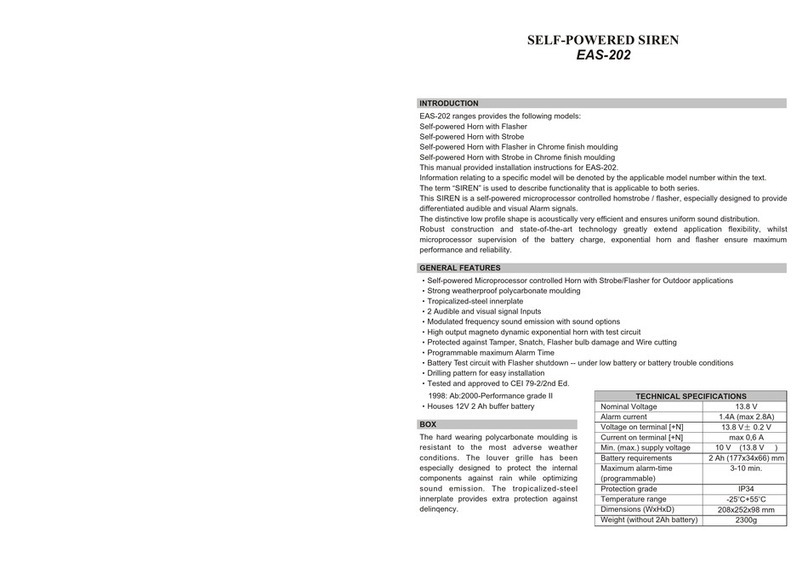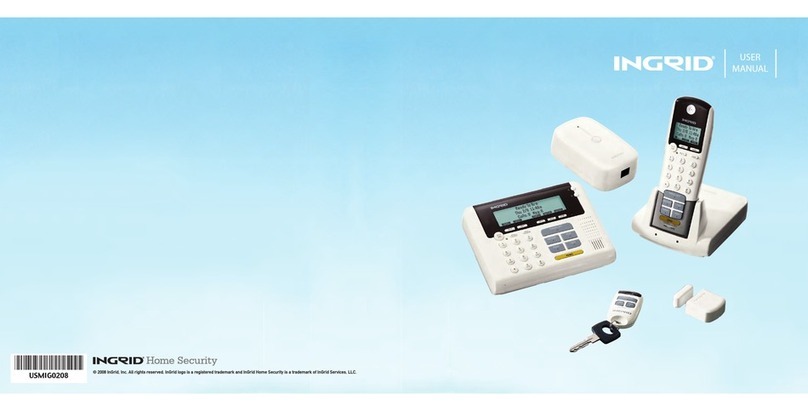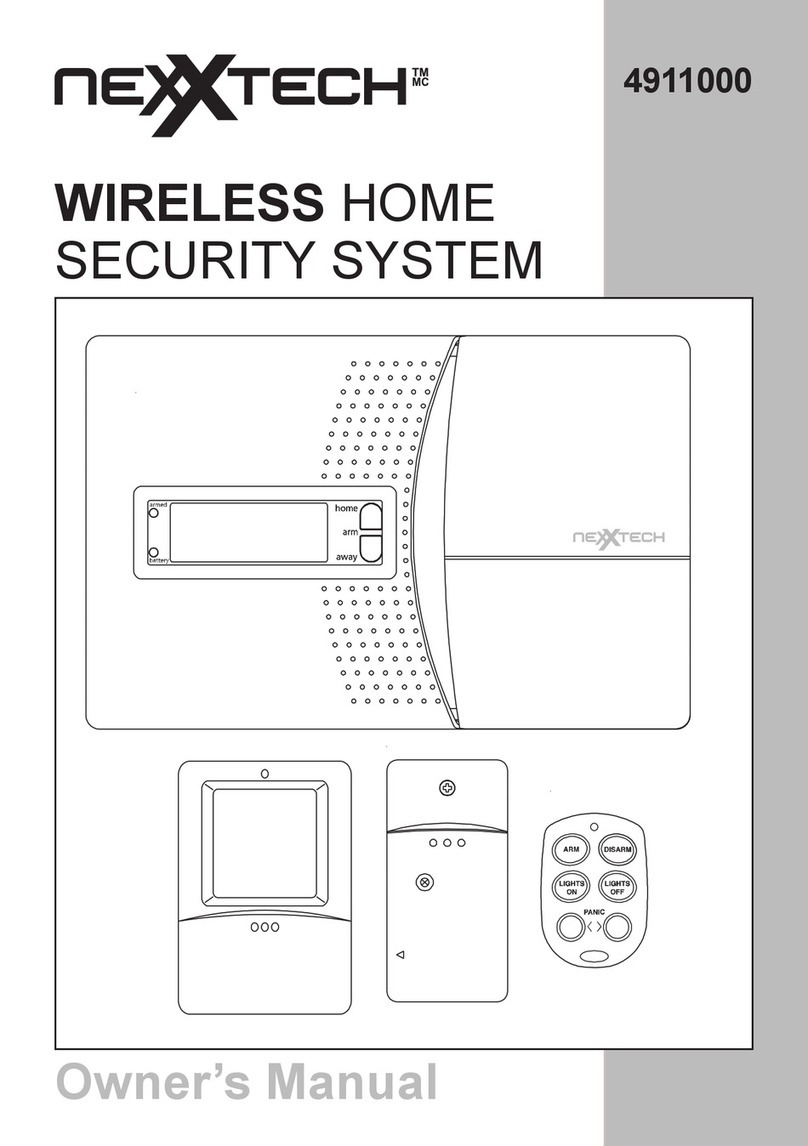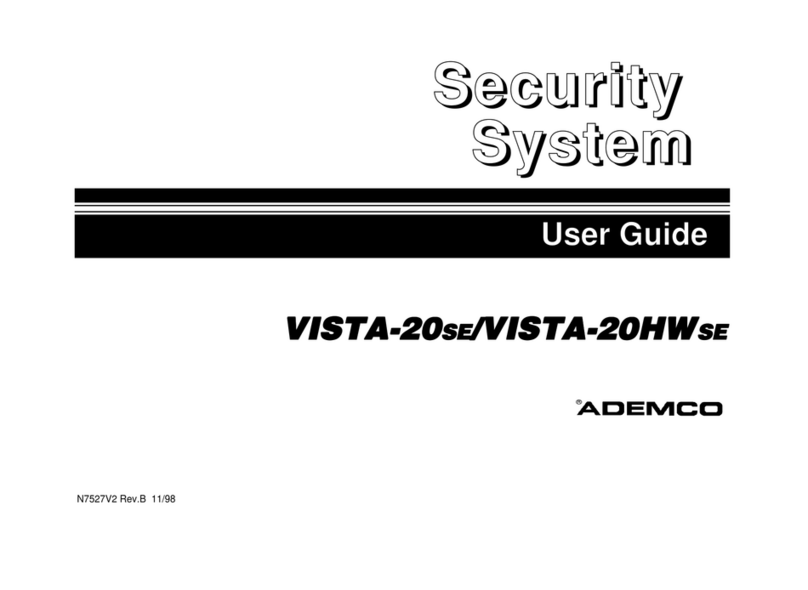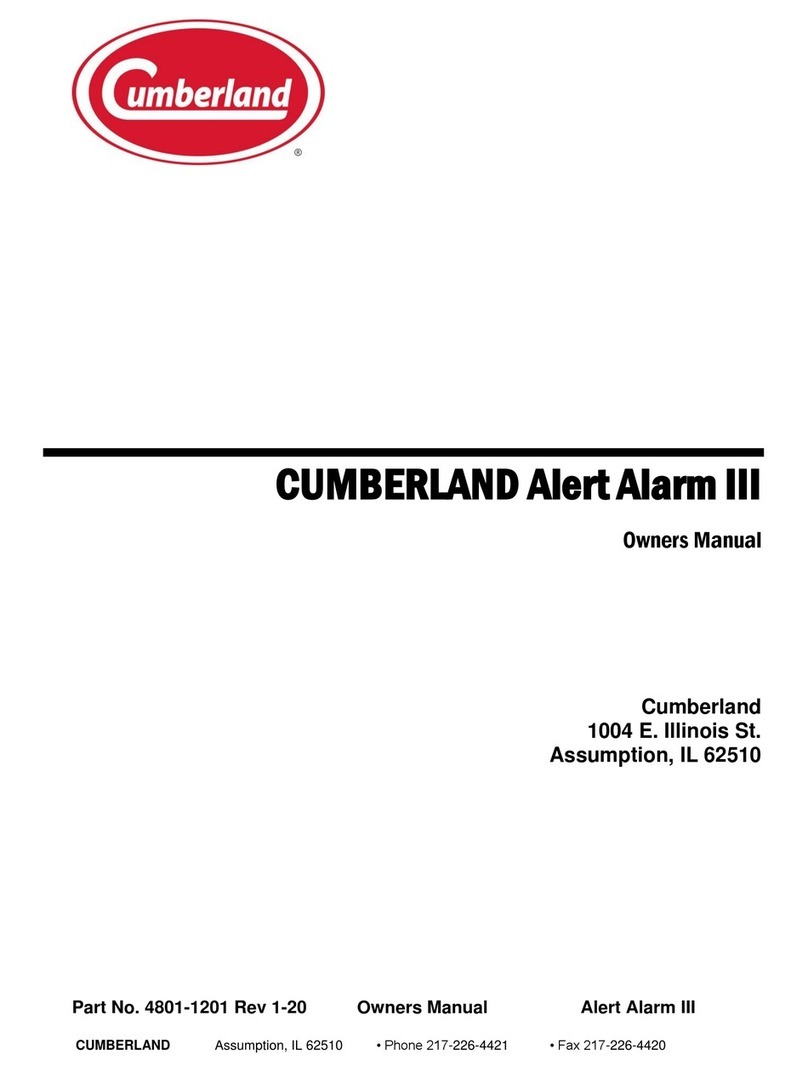EDAC 400-02 User manual

Page 1 of 40
INTRODUCTION.......................................................................................................................... 3
SPECIFICATIONS ....................................................................................................................... 4
INSTALLATION........................................................................................................................... 6
Installation Requirements ......................................................................................................... 6
Telephone Line Connection...................................................................................................... 8
Wall Socket Installation............................................................................................................. 8
HOW THE EDAC 400-02 WORKS............................................................................................... 9
Run Mode................................................................................................................................. 9
Making Alarm Notification Calls ................................................................................................ 9
Cancelling Alarm Notification Calls ..........................................................................................10
INTRODUCTION TO PROGRAMMING YOUR EDAC 400-02 ................................................... 11
Introduction –Program Mode...................................................................................................11
Explanation of prompts –Program Mode.................................................................................11
Entering Programming Mode...................................................................................................11
Programming Example ............................................................................................................11
The *Key - Program Checking...............................................................................................12
Exit to RUN Mode....................................................................................................................12
Restore Factory Defaults .........................................................................................................12
GETTING STARTED QUICKLY - Example............................................................................... 13
Entering Programming Mode...................................................................................................13
Programming Telephone Numbers..........................................................................................13
Recording a Site Message.......................................................................................................13
Replaying the Recorded Message...........................................................................................14
Exit to Run Mode.....................................................................................................................14
Testing the EDAC 400-02........................................................................................................14
PROGRAMMING –GLOBAL PARAMETERS........................................................................... 15
Function F00 Modify PIN Number........................................................................................... 15
Function F02 Call Progress..................................................................................................... 15
Function F03 Ring-back Trigger Cancellation......................................................................... 16
Function F04 Answer Incoming Calls When any Input Active.................................................. 16
Function F05 Answer Incoming Calls When all Inputs are Cancelled...................................... 17
Function F06 Answer Incoming Calls When no Inputs Active (Idle)......................................... 17
Function F07 Call List Priority & Rosters................................................................................. 18
Function F08 Outputs ............................................................................................................. 19
Function F09 Trigger/Dial Time............................................................................................... 19
Function F96 Trigger/Dial Mode.............................................................................................. 20
Function F99 Send Model Information via RS232................................................................... 20
PROGRAMMING –RECORDING VOICE MESSAGES............................................................. 21
Function F0* Recording Voice Messages ............................................................................... 21
RECORD example...................................................................................................................22
PLAY example.........................................................................................................................22
PROGRAMMING –INPUT SPECIFIC PARAMETERS.............................................................. 23
Function F10 Programming Your Pager Messages................................................................. 23
Function F11 Programming Your Telephone/Pager/SMS Numbers........................................ 23
Call Types............................................................................................................................... 24
Function F15 Programming an SMS/Paging Access Number................................................. 25
Function F51 Setting Inputs to Trigger or Report .................................................................... 26
Function F52 Physical Input Trigger Configuration.................................................................. 26
Function F53 Wait Time Between Calls .................................................................................. 27
Function F54 Pager Delay Time ............................................................................................. 28
Function F55 Message Play Time........................................................................................... 28

Page 2 of 40
Function F56 Call Counter...................................................................................................... 29
Function F57 SMS/Paging Service Password......................................................................... 29
Function F58 SMS/Paging Service ID..................................................................................... 30
PROGRAMMING –JUMPER SETTINGS.................................................................................. 31
APPLICATION NOTES.............................................................................................................. 32
Using Outputs......................................................................................................................... 32
Using Paging .......................................................................................................................... 33
Numeric Pager.........................................................................................................................33
Alpha-Numeric pager/Text messaging (SMS)..........................................................................33
Modem Communications.........................................................................................................35
Programming Using RS232 .....................................................................................................35
FREQUENTLY ASKED QUESTIONS........................................................................................ 36
COMPLIANCE NOTES.............................................................................................................. 37
NOTICE TO AUSTRALIAN USERS.........................................................................................37
NOTICE TO NEW ZEALAND USERS .....................................................................................37
GLOSSARY............................................................................................................................... 38
WARRANTY .............................................................................................................................. 39
INTERNATIONAL CONTACT DETAILS.................................................................................... 40

Page 3 of 40
INTRODUCTION
The EDAC 400-02 is a cost-effective, auto reporting dialler designed for industrial, domestic and
small-business use. The EDAC 400-02 is an effective tool for alerting the user to events such as
faults or changes in equipment state. It is physically compact, consumes little power and can be
installed very quickly. Its ease of programming combined with simple installation make it highly
attractive and cost effective in monitoring applications.
The EDAC 400-02 is activated by a contact closure, or opening, which results in the start of a
user-defined dialling sequence, followed by the transmission of either an 8-second voice
message or a 20-character pager/SMS message (subject to network availability).
When an event triggers the auto-dialler, the EDAC 400-02 will make an alarm notification call.
The EDAC 400-02 will pick up the phone line and call a list of people via telephone, cell phone or
pager. The EDAC 400-02 speaks the pre-recorded message announcing the problem.
Upon receipt of an alarm call you may reset the EDAC 400-02 by simply pressing a numeric digit
on your telephone keypad or by entering a user-defined PIN number. This will stop the unit
making further alarm notification calls. Alternatively, the EDAC 400-02 may be interrogated by
calling into it and listening to the voice message. This provides the opportunity to
cancel/acknowledge the alarm inputs via the telephone keypad. This option would normally be
used when the EDAC 400-02 is operating in conjunction with a pager and/or SMS messaging.
Other options, such as Outputs, are user programmable either on site or remotely (via a
telephone).
Once the EDAC 400-02 is in a cancelled state, the EDAC 400-02 will suspend its dialling
sequence and remain cancelled until the event that triggered the alarm has been removed
(cleared). If the EDAC 400-02 does not receive acknowledgment of an alarm, it will remain in
dialling mode until the event that triggered the alarm is cleared, or the user-defined call count limit
is reached.
All telephone numbers, messages, and functions are user programmable via a keypad and a
single character display.
The EDAC 400-02 has numerous programmable features that enable it to be a flexible telemetry
monitoring tool suitable for use in any situation. If you require information about the EDAC 400-02
and how it can be used with your monitoring application, please contact your supplier. For online
manuals for all EDAC products, use the EDAC web site http://www.edacelectronics.com/support.

Page 4 of 40
SPECIFICATIONS
Connections
1.5 mm screw terminals are provided for all electrical connections to the EDAC 400-02.
Power
Voltage 12-15V DC
Current 40mA idle 80-100mA active
NOTE: Power supply should comply with Telecom PTC101 requirements if dialler is to be
connected to Telecom NZ network and ACA requirements if dialler is to be connected in
Australia. (Such as EDAC PB12)
Inputs
Four, clean-contact, voltage-free trigger inputs such as relay contacts, a float switch or a micro
switch are required.
WARNING: Applying voltage to the Inputs of the EDAC 400-02 may
damage the EDAC 400-02 and will void the product warranty.
Outputs
Up to four Outputs by jumper selection. Open collector type. Maximum current is 120mA per
output. Each Output takes up one input channel.
Telecom Line
Two RJ11 sockets. A suitable cord can be provided compatible with the wall socket in your
country. The inner two pins of the RJ11 socket are used for TIP + RING.
RS232 Connector (DB9)
Used for programming EDAC 400-02 configuration via Hyper Terminal and a PC. See section
‘Programming using RS232’ in ‘Application Notes’ for detailed instructions. Alternatively it can be
plugged into a PLC/RTU or SCADA system, allowing the unit to provide a 2400 baud modem
connection to an external device.
Mechanical
Dimensions 192mm length x 110mm width x 35mm height.
Weight 250gm
Cabinet Aluminium base with screw on (M4 pozi-drive) aluminium lid.
Finish White epoxy powder coat.
Mounting 4 x 4mm mounting holes in the base of the cabinet.
Line in/Line out RJ11 standard (only the 2 inner pins are used as Tip + Ring).
Messages
Site Message Four seconds of high-quality, user-recordable speech.
I/O Messages Eight seconds of high-quality, user-recordable speech per I/O.
Acknowledged Four seconds of high-quality, user-recordable speech to identify
when message inputs have been acknowledged.
Idle Message Four seconds of high-quality, user-recordable speech to identify
when the EDAC 400-02 inputs are in an idle state.
Parameters
Maximum number of telephone numbers Four per Input or one list of 16 numbers
Maximum number of digits per number Twenty including pauses
Time duration of phone call (playtime) Variable 1 - 9 minutes
Wait time (between each call) Variable 0 - 9 minutes.
PABX access delay Two seconds for each user inserted pause
Recordable message time Up to eight seconds per Input
Dialling mode DTMF (tone dialling)

Page 5 of 40
Numeric Paging
Twenty-digit numeric strings can be transmitted to a Numeric Pager to identify the site and active
input trigger. Numeric paging can be configured via the EDAC 400-02 keypad.
Alphanumeric Paging
Multiple paging hosts can be used. A different host can be assigned to each Input trigger.
Paging host protocol TAP
Pager messages 20 characters per Input (i.e. 4 messages)
Max number of pagers 16
Host password User programmable
Host ID User programmable (default PG1)
Modem
The EDAC 400-02 has an onboard 2400 baud V22bis modem (backward compatible with 1200
V22 connections) used for alphanumeric paging and remote configuration using Hyper Terminal.
The EDAC 400-02 can also be put into transparent mode. This allows remote communications
via a dial-up connection, to devices attached to the external RS232 connector such as a PLC or
RTU.
Programming
Functions (including voice), are normally programmed using the keypad and single character
display. The EDAC 400-02 can also be programmed through the inbuilt RS232 connector and
Hyper Terminal; a Windows based application shipped with all versions of Windows. See section
‘Programming using RS232’ in ‘Application Notes’ for detailed instructions.
Alarm Cancellation
Alarm notification calls can be cancelled by using a DTMF touch-tone phone. The alarm can be
cancelled by pressing any numeric key on your telephone keypad or by entering a PIN,
depending on which option you have selected at the time of installation and programming.

Page 6 of 40
INSTALLATION
Installation Requirements
The typical wiring schematic is shown in Figure 1.
Figure 1: Typical EDAC 400-02 Installation
Power Supply
A DC regulated power supply complying with Telecom PTC101 or ACA regulations is required
(such as EDAC PB12). The DC power supply should be normally constant, between 12 and 15
volts. An optional battery backup power supply (EDAC PB12) is required to maintain operation
during a mains failure event.
Input Triggers
The input trigger causes the EDAC 400-02 to commence the dialling sequence. A clean contact,
voltage-free input is required. This would normally be via an external relay or switch. The EDAC
400-02 is configured by default for a normally open type input. Alternatively the user can
configure any of the inputs to accept a normally closed type input (see function F52).
Some examples of these types of triggers might be a relay output, a micro-switch or a float
switch. Any of the inputs can be configured as either an input or an output (see function F08).
NOTE: The activating trigger must be installed correctly and maintained to
prevent false triggering.
Earth Discharge
The EDAC 400-02 has a separate Earth Discharge Circuit, which is used to protect the EDAC
400-02 and any attached equipment from lightning strikes and other external high voltage
transients, which may travel down the phone line. The Earth Discharge circuit must be connected
to a common earth point. These are usually found at a switch board earth point (earth buss bar).
The Earth Discharge should be connected using a M3 ring terminal to the bottom right PCB
screw (near phone/line sockets).
Trigger Inputs
Power Supply
12 –15V DC
+ -
Exchange Line
Phone
EDAC 400-02
Line Out
Line In
Input 1 / Output 4
Input 2 / Output 3
- (Supply Ground)
+ (Supply 10-30V DC)
Input 3 / Output 2
Input 4 / Output 1
Power fuse
Earth Discharge Connection Point
500mA
Outputs
Relay

Page 7 of 40
Telephone Line
The EDAC 400-02 does not require a separate line and can be inserted as a master upstream
device in an existing telephone connection (see Secure Installation on next page). An RJ11 plug
and socket system is used. You must use the cord-set provided to connect the EDAC 400-02 to
the Telecom wall socket or the EDAC 400-02 may not work and no alarm notification calls will be
made. Extra cords are available upon request for a small charge. The EDAC 400-02 may be used
with a PABX (Private exchange) but it must be connected to an analog line.
WARNING: If the existing phone system has lights on the phone it is
probably a digital PABX system.
Do not plug the EDAC 400-02 into a digital phone system unless you are sure
that it supports standard analog phone equipment. Plugging the unit into an
incorrect phone system will cause severe damage to the equipment and void
the warranty. If there is any uncertainty please contact the supplier where you
purchased your PABX for more information.
Points to Note:
The EDAC 400-02 can be connected between the telephone line (trunk) and the PABX
or it can be used on an extension.
When connected to a PABX and an extension, ensure that the extension socket the
EDAC 400-02 is plugged into remains active during a power failure. Refer to your
PABX instructions or contact your supplier.

Page 8 of 40
Telephone Line Connection
The following schematic diagrams show typical EDAC 400-02 phone line installations:
Wall Socket Installation
Figure 2 shows a typical single wall socket installation and requires two telephone-related
connections. Other telephones left off-hook may prevent the EDAC 400-02 from making calls.
Figure 2: Wall Socket Installation
Secure Installation
This is a master upstream device configuration and may require Telecom assistance to remove
the connection between the first wall socket and other wall sockets, as shown below. On an
alarm input trigger, the EDAC 400-02 takes over the telephone line, disconnecting all other calls.
The alarm condition is immediately acted on and cannot be stopped by unauthorised means.
When not triggered, the EDAC 400-02 has no effect on the phone line.
Figure 3: Secure Installation
Extra cord required
Telecom Line
(Trunk)
Line in Line out
EDAC 400-02
Telecom Line
(Trunk)
Line in Line out
EDAC 400-02

Page 9 of 40
HOW THE EDAC 400-02 WORKS
Run Mode
On power-up, the EDAC 400-02 will be in RUN mode assuming no trigger is present. RUN mode
can be identified by a horizontal line on the display with a flashing dot.
The EDAC 400-02 uses three distinct states when in RUN mode:
Active
When the EDAC 400-02 is active (in alarm state) the unit will make alarm notification
calls.
Cancelled or acknowledged
When the EDAC 400-02 is active (in alarm state) the unit will make alarm notification
calls. When these active trigger states (inputs) have all been acknowledged the EDAC
400-02 is said to be in a cancelled state. This means that the EDAC 400-02 will not make
any further calls. The input is still present however and it must be removed in order to re-
trigger the EDAC 400-02. Any new trigger on a different alarm input will initiate a new
alarm notification call sequence.
Cleared or Idle
The input is cleared when it no longer meets the input criteria (e.g. trigger on closed
contact and the contact is open). The EDAC 400-02 is idle when all inputs are clear (i.e.
no inputs present).
These states can normally be identified by the following symbols on the display.
= Cleared or Idle (default at power up)
= Active (Looking for dial tone / dialling)
= Active (Call connected, speaking / sending messages)
= Active (In retry loop, waiting to make next call)
= Cancelled or acknowledged (EDAC 400-02 cancelled)
Making Alarm Notification Calls
When an event triggers an alarm notification call, the EDAC 400-02 will dial through the
telephone number call list. When the call is answered, the voice message is spoken or the pager
message sent. This process is broken down into the following stages:
1. All inputs are idle (no alarms are being triggered).
2. An input meets the alarm-trigger criteria (see functions F51 and F52).
3. The EDAC 400-02 waits for the trigger/dial time to elapse (the time between the alarm
trigger and the first phone call being made). If the input is removed before the EDAC 400-
02 has had time to place a call the input state goes back to idle unless the input is set to
latch. (see functions F09, F52 and F96)
4. The EDAC 400-02 will now make calls to the people on your call list (see functions F07
and F11).
When a call is answered and it is a voice call (telephone, cell/mobile phone, etc) it will speak the
message sequence outlined below.
Your site message (identifies the site)
The Input messages (identifies which alarms have been triggered)
The cancellation message (if you cancel the alarms) “The following Inputs have
been acknowledged”
The Input messages again (if the alarms are cancelled but the Input triggers have
not been removed)
The site message is repeated at the end of the message sequence.

Page 10 of 40
This message sequence will be spoken repeatedly for whatever length of time you have set for
‘Function F55 Message Play Time’.
Once the message play time (see ‘Function F55 Message Play Time’) has been reached, the
EDAC 400-02 will hang up the call. The EDAC 400-02 now waits for the time programmed in
‘Function F53 Wait Time Between Calls’ before making the next call in the call list (function F53).
An ‘r’will be displayed indicating the dialler is in a retry state.
On receiving an alarm notification call, you should acknowledge (cancel) the alarm by pressing
any key or entering the PIN number. This will stop the EDAC 400-02 from making more calls.
If the EDAC 400-02 hangs up before you have time to cancel, you can dial into the unit to cancel
it (functions F03, F04, F05 and F06 to set cancellation options).
Cancelling Alarm Notification Calls
When the EDAC 400-02 is cancelled or acknowledged it will stop trying to make alarm notification
calls. An alarm notification call is cancelled by one of three ways:
User Acknowledgement by key-press on telephone
User Acknowledgement by calling into EDAC
Self-Cancel by counting calls.
User Acknowledgement by key-press on telephone
If you receive a call from the EDAC 400-02 and wish to acknowledge (cancel) the call, stopping
further calls being made, press the any numeric key (0-9) on your telephone keypad while the
alarm message is playing. The option of cancelling using a PIN can be set in ‘Function F11
Telephone Pager Numbers’.
The EDAC 400-02 will respond with beeps to confirm it has received your key presses and then
announce which inputs have been acknowledged. At this point, user may hang up their
telephone. No other calls will be made by the EDAC 400-02 until a new trigger signal occurs.
If you do not wish to acknowledge the alarm, press the #key to make the EDAC 400-02 hang
up and call the next number in its call list.
If you have acknowledged the alarm, pressing #will put the EDAC 400-02 into modem mode
(you will hear fax tones). Hang up your phone –the EDAC 400-02 will automatically time-out and
stop making further calls.
Pressing *0# will acknowledge the call and make the EDAC 400-02 hang up immediately.
No further alarm notification calls will be made.
User Acknowledgement by calling into EDAC
This method is normally used to allow the EDAC 400-02 to be cancelled after receiving a call on
your pager. It can also be used if the EDAC 400-02 hangs up before you have time to cancel. Go
to a telephone and ring the telephone number of the EDAC 400-02. The EDAC 400-02 will
answer and play messages to announce its current status. You may cancel (if allowed) by
pressing any key on your phone or entering your PIN on your telephone keypad
Self-Cancel by counting calls
When the number of calls set in ‘Function F56 Call Counter’, is reached, the alarm condition is
cancelled and the EDAC 400-02 will not make any further calls.

Page 11 of 40
INTRODUCTION TO PROGRAMMING YOUR EDAC 400-02
Introduction –Program Mode
In order to program phone numbers, voice messages and other parameters into the EDAC, it
must be put into ‘Program Mode’. In this mode the EDAC is ready to store entered parameters for
use later when in ‘Run Mode’. The EDAC uses a series of key sequences and prompts to enter
parameters. These are explained below
Explanation of prompts –Program Mode
The ‘F’prompt indicates the EDAC 400-02 is in programming mode and is waiting for you
to select a function.
The ‘P’prompt indicates that a function (‘F’) has been selected and the EDAC 400-02 is
awaiting parameter (‘P’) entry for this function.
The ‘E’prompt indicates the EDAC 400-02 has detected an error in the data entry process,
or a function is empty. Note that the ‘E’is also displayed for the number 12 in some
functions.
The ‘t’prompt indicates the EDAC 400-02 is waiting for you to enter a call type. The
seven-segment display cannot create a ‘t’character but the picture above is an accurate
diagram of this prompt.
The ‘r’prompt indicates that a voice message is recording.
Entering Programming Mode
Press 1234 (The factory default PIN number)
The ‘F’ prompt will appear on the display.
If your PIN is not working, turn the EDAC 400-02 off and hold down a key while powering up. The
product will first display the firmware version (e.g. 3.5.3.) then go into programming mode and
display the ‘F’ prompt.
Programming Example
Below is an example of a prompt and key-press sequence for setting the call progress function.
Programming of all functions in the EDAC follows a very similar sequence. The large segment
characters represent prompts on the display of the EDAC. The key type characters (abc)
represent input from the user on the keypad.
The example below will set the Call Progress function (F02) to ‘dial tone detect only’. (P1)
02
Call Progress
1
Dial tone detect only.
The EDAC will often play back any user entry on the display so the user can check the correct
value was entered. The EDAC will always return to the ‘F’ prompt when an entry sequence is
complete.

Page 12 of 40
The *Key - Program Checking
The *key is used to display current parameter data held in the EDAC 400-02. Select a function
and, when the ‘P’is displayed, press the *key. The data currently held in that function will
display (digit by digit in the case of multi-digit entries).
Exit to RUN Mode
Once all the functions have been programmed, exit programming mode by pressing ## very
quickly at the ‘F’ prompt. The EDAC 400-02 should now display the with a flashing dot. In
RUN mode the EDAC 400-02 is ready to accept an input trigger and make alarm notification
calls.
##= Exit programming to RUN mode.
Restore Factory Defaults
Use this function to clear old or unknown parameters (user settings) and return to factory
settings. You can then reprogram each function from the default starting point
NOTE: This procedure does not affect any existing voice messages.
WARNING: The following instructions will clear your user settings from all
functions associated with an input, e.g. #1 will clear the phone/pager
numbers, trigger type, wait time, message play time and call counter for input
one. If you wish to reset only one or two functions, look up those functions in
this manual and simply reprogram the data.
#0= Clear general parameters (functions F01 to F09).
#1= Clear phone numbers and all parameters for Input 1.
#2= Clear phone numbers and all parameters for Input 2.
#3= Clear phone numbers and all parameters for Input 3.
#4= Clear phone numbers and all parameters for Input 4.

Page 13 of 40
GETTING STARTED QUICKLY - EXAMPLE
Below is a brief description of how to quickly set up the essential functions of the EDAC 400-02.
This simple configuration example will take you through the steps needed to:
Program one telephone number for your alarm notification call list.
Record one voice message to identify the site (location of the alarm).
Record one voice message to report the alarm condition.
Replay the recorded voice message so you can check it.
Apply a physical trigger to any input (1-4) to initiate an alarm notification call and test
that the unit is working.
Entering Programming Mode
Press 1234(the factory default PIN number).
The ‘F’ prompt will appear on the display.
If your PIN is not working, turn the EDAC 400-02 off and hold down a key while powering
up. The product will go into programming mode and display the ‘F’ prompt.
Programming Telephone Numbers
There are a number of phone number storage options with a maximum of 16 different
numbers. For full instructions on how to program telephone numbers, refer to ‘F11
Programming Your Telephone / Pager / SMS Numbers’ and ‘F07 Call List Priority and
Rosters’ for full instructions
To enter phone or PABX extension number one:
11
Enter number followed by a #to save
e.g.
0243256#
Then
Enter the call type 1This means voice call, cancel using any key).
The EDAC 400-02 will then redisplay the entered telephone number
followed by the call type so that you may verify their accuracy.
The dialler will return to the ‘F’prompt.
Recording a Site Message
When recording voice messages speak clearly into the microphone located inside the lid
in the top left hand corner of the circuit board.
0*
0
#= Recording starts as soon as the #key is
pressed.
Press any key to finish the recording.
Press any key to
finish recording
The message will then play until any key is
pressed.
Press any key again and the dialler will return to the ‘F’ prompt.

Page 14 of 40
Recording Input Trigger one Voice Message
0*
1
#= Recording starts as soon as the #key is
pressed.
Press any key to finish the recording.
The message will then play
until a key is pressed.
Press any key again and the EDAC 400-02 will return to the ‘F’ prompt.
See function F0* for the full list of voice message functions.
Replaying the Recorded Message
0*
1
*= Playback starts as soon as the *key is
pressed.
The message will then play
until any key is pressed.
The EDAC 400-02 will return to the ‘F’ prompt when complete.
Exit to Run Mode
##= Exit programming to RUN mode.
Once all these functions have been programmed, exit programming mode by pressing
## very quickly at the ‘F’ prompt. The EDAC 400-02 should now display the with a
flashing dot. In RUN mode the EDAC 400-02 is ready to accept an input trigger and make
alarm notification calls.
Testing the EDAC 400-02
By default the input is set up for normally open.Connecting the input terminal to negative
supply will trigger the EDAC 400-02.
Ensure the EDAC 400-02 is connected to an analog phone line. Use a paper clip or small
piece of wire to connect any input to ground (third terminal from the left). This will make a
closed connection, causing the input to trigger and the EDAC 400-02 to make an alarm
notification call.

Page 15 of 40
PROGRAMMING –GLOBAL PARAMETERS
Function F00 Modify PIN Number
The factory default PIN is 1234. If you forget the PIN your can still enter programming mode
by holding down any key when applying power to the EDAC 400-02.
00
Enter any 4-digit number. Please
remember your new PIN or write it
here.
Default: 1234
Function F02 Call Progress
This Function determines if the EDAC looks for dial and/or ring tone when making an alarm
notification call. It also uses this setting to determine if a call has been successful or not. For the
call counter to be incremented the call must be successful, therefore the conditions of this
function must be met.
For example if ‘Dial tone Detect only’ is used the EDAC must detect dial tone for a successful call
to be made and for the call counter to be incremented.
Using dial tone detection only is recommended.
02
0= No tone detect (blind dial).
Picks up the line, waits five seconds then dials the
number. The voice messages are then spoken for
the play time (set in function F55).
1= Dial tone detect only.
Picks up the line and makes two attempts to detect
dial tone. If detected, it dials the number and the
voice messages are spoken for the play time (set
in function F55). If not detected tries the next
number.
2= Ring tone detect only.
Picks up line as 0 (no tone-detect) above. If tones
other than RING tone are detected the call is
aborted and the next number is tried. Once
ringing, the EDAC 400-02 must detect silence
before speaking message.
3= Dial and Ring.
Detects both dial tone and ring as in 1 and 2 above.
Default: 1 (Dial tone only)
Note: Please see section ‘Compliance Notes’ on page 38

Page 16 of 40
Function F03 Ring-back Trigger Cancellation
When an input is active, the dialler will attempt to make calls. If the input (see F53) allows a wait
time between calls and the dialler will answer incoming calls (also see F04, F05, and F06).
The caller may then cancel the input (as below).
03
0= Caller cannot cancel Inputs.
The EDAC 400-02 will play its voice
messages and not stop making calls.
1= Input cancelled by any number key.
Pressing *and #does not cancel the
Input.
2= Input cancelled by PIN.
Default: 1 (Cancel by any number key)
Function F04 Answer Incoming Calls When any Input Active
When an input is active the EDAC 400-02 will attempt to make alarm notification calls. Setting a
wait time (function F53) gives you the opportunity to call into the EDAC 400-02 and cancel the
input. When an input is cancelled, the alarm condition still exists but the EDAC 400-02 will stop
making alarm notification calls.
The EDAC 400-02 will only use this function and its setting when any input is active.
04
Answer all calls after …
2to 9= 2 to 9 rings,
#= 12 rings when any Input is active.
(Displays an ’E’. NB: This is not
an error).
0= Never answer any incoming calls
when any Input is active.
Default: 4 (Answer after four rings when any Input active)

Page 17 of 40
Function F05 Answer Incoming Calls When all Inputs are Cancelled
When an Input is cancelled, the alarm condition still exists but the EDAC 400-02 will stop making
alarm notification calls. If you wish to monitor the status of an alarm you can call into the EDAC
400-02 periodically and listen to its message. Monitoring Input (alarm) status can be useful as
certain alarm conditions may go away by themselves e.g. electrical power will be automatically
restored after a power failure. In this instance the alarm condition is removed automatically and
the EDAC 400-02 will reset itself to the idle state.
The EDAC 400-02 will only use this value when all active Inputs are cancelled but not removed.
05
Answer all calls after …
2to 9= 2 to 9 rings.
#= 12 rings when all active Inputs
are cancelled.
0= Never answer any incoming
calls when all active Inputs are
cancelled.
Default: 4 (Answer call after four rings)
Function F06 Answer Incoming Calls When no Inputs Active (Idle)
You may wish to periodically dial into the EDAC 400-02 to confirm that it is in idle state. This can
be useful if you have previously received a notification call of an alarm which may cancel itself
e.g. electrical power will be automatically restored after a power failure. Because the alarm
condition is removed, the EDAC 400-02 will reset itself to the idle state.
The EDAC 400-02 will use this value only when there are no Inputs active and is in the idle state.
06
Answer all calls after …
2to 9= 2 to 9 rings,.
#= 12 rings when idle.
0= Never answer any incoming
calls when idle
Default: 4 (Answer calls after four rings)
NOTE: If using Outputs you will need to consider appropriate values for functions
F04, F05 and F06, to ensure the EDAC 400-02 answers the phone appropriately.
For installations that only use voice alarm notification calls where no user call back is required,
functions F04, F05 and F06 can be set to zero ensuring the EDAC 400-02 will never answer an
incoming alarm call. This allows the phone line to be used for other day-to-day activities. This
configuration requires that the operator acknowledges the alarm notification call on the phone
they receive the call on.

Page 18 of 40
Function F07 Call List Priority & Rosters
The EDAC 400-02 can be programmed with up to 16 different phone numbers. By default the
programmed numbers are treated as a single list of 16 numbers. Using F07 the list can be
divided up in to blocks of 4, or 8 and treated differently depending on the alarm Input trigger
number.
The list of telephone/pager numbers can be configured in a number of ways including rosters.
A roster is used to assign a specific call list to be used to call only the people who will be on duty
that day. You can use four separate lists of four phone numbers, and change which list is to be
used either remotely or on site.
When the call is established and the EDAC 400-02 is speaking the idle message, the current
roster may be changed by pressing *followed by the roster number (1,2,3or 4).
07
1= All Inputs use list 1 (F11 to F14).
2= All Inputs use list 2 (F21 to F24).
3= All Inputs use list 3 (F31 to F34).
4= All Inputs use list 4 (F41 to F44).
5= All Inputs use a combined 16 number list:
list 1, list 2, list 3 and then list 4.
6= Each Input uses its own list. Calls are alternately
taken from each list in turn when more than one
Input is active.
7= Inputs 1 & 2 use list 1 & 2. Inputs 3 & 4 use list 3 &
4 (two 8-number lists)
9= Each Input uses its own list. Inputs with a lower
Input number are completed first.
Default: 5 (One list of 16 numbers)
Rosters 1-4

Page 19 of 40
Function F08 Outputs
All 4 Inputs can be used as pull down (open collector type) Outputs. A physical terminal can be
used either as an Input or Output but not both. Any combination of Inputs and Outputs can be
configured. See section Specifications for max current and voltage ratings.
These Outputs are independent from any Input and are toggled by a key press once a call is
established and a suitable PIN has been entered to gain access to ‘Output Mode’. An operator’s
pre-recorded voice message provides feedback to the operator as to the status of the Output e.g.
‘The heater is On’ or ‘The heater is Off’.
See ‘Using Outputs’ in the Application Notes section for more information on using outputs
The numbers used to identify Outputs are the opposite of the Input numbers, i.e. Input 4 is
Output 1. Please refer to the table below to see which Inputs correspond to which Outputs.
Input 1
Output 4
Input 2
Output 3
Input 3
Output 2
Input 4
Output 1
08
0= All triggers are Inputs (no Outputs).
1= Output 1 and trigger 1, 2 & 3.
2= Output 1 & 2 and trigger 1 & 2.
3= Output 1, 2 & 3 and trigger 1.
4= All triggers are used as Outputs.
Default: 0 (All Inputs)
Function F09 Trigger/Dial Time
This function determines the period to wait from physical trigger to alarm condition and dial out. It
can be used as a trigger delay timer to allow for exit / entry time, or can be used with float
switches to ensure the level has reached and is triggering the float switch correctly.
The latch capture, (function F52)occurs either when triggered, or at the end of the trig/dial time.
The value displayed is seconds by default. Minutes may be used (see function F96)
09
0= Immediate dial (default).
1= 1 sec/min 2= 2 sec/min
3= 3 sec/min 4= 5 sec/min
5= 10 sec/min 6= 15 sec/min
7= 20 sec/min 8= 30 sec/min
9= 60 sec/min #= 120 sec/min
Default: 0 (Start dialling when triggered)

Page 20 of 40
Function F96 Trigger/Dial Mode
When an alarm input is present the EDAC 400-02 will trigger. The EDAC 400-02 will not begin
calling until the trigger/dial time has passed (see function F09). Function F96 is used to set the
units used (seconds or minutes) by the trigger/dial time in F09.
When the input is latching the input can be latched either at the trigger time or at the dial time
(see function F52). Latch on trigger means once the EDAC 400-02 has been triggered it will
continue until it is acknowledged. If the input is set to latch on dial and the trigger is removed
before the dial has commenced the EDAC 400-02 will cancel and stop making calls. With function
F52 set as non-latching, the latch on trigger and latch on dial have no effect. The trigger dial time
is always relevant.
96
0= Latch on trigger & trigger/dial time is in seconds.
1= Latch on trigger & trigger/dial time is in minutes.
2= Latch on dial & trigger/dial time is in seconds.
3= Latch on dial & trigger/dial time is in minutes.
Default: 0 (Latch on trigger & trigger/dial time is in seconds)
Function F99 Send Model Information via RS232
This function makes the EDAC 400-02 send an identification string via the RS232 connector. By
using this function from the keypad you can send text to a PC. This is a good way to check if the
PC is correctly connected and communicating. You need to be running Hyperterm or a similar
terminal emulation program. The text is sent as 1200bps, ASCII 8-bit, no parity, one stop bit.
99
Sends banner text at 1200bps via the
RS232 connector.
Table of contents
Other EDAC Security System manuals
